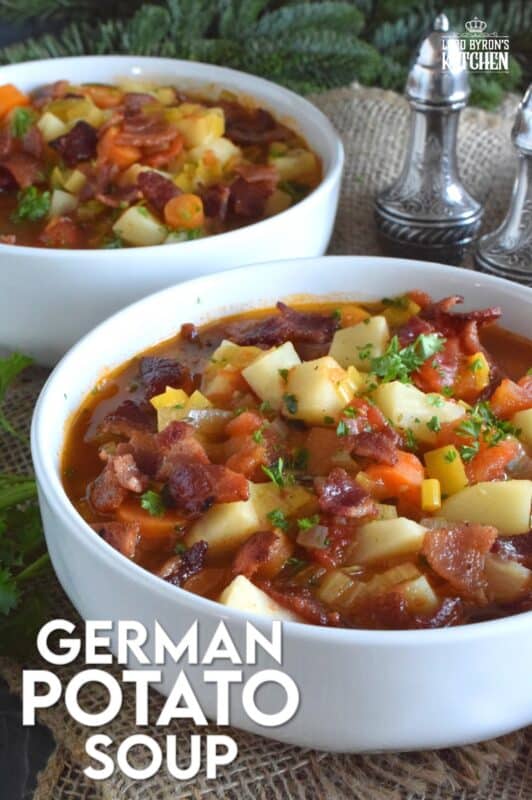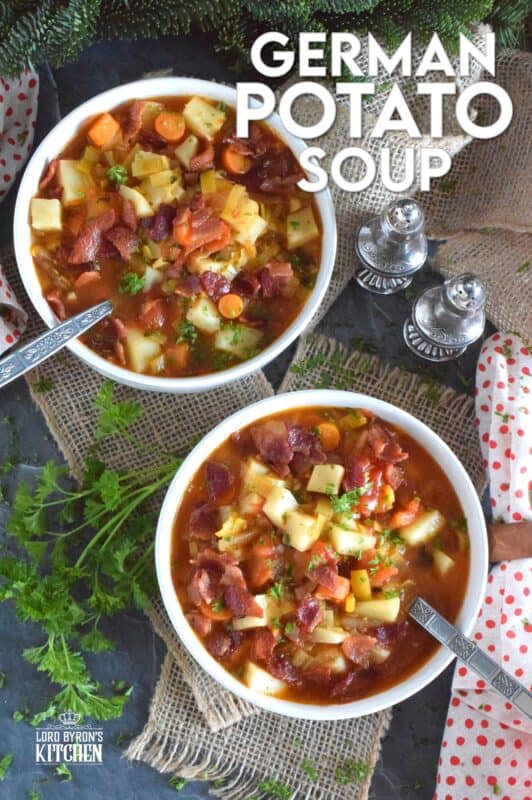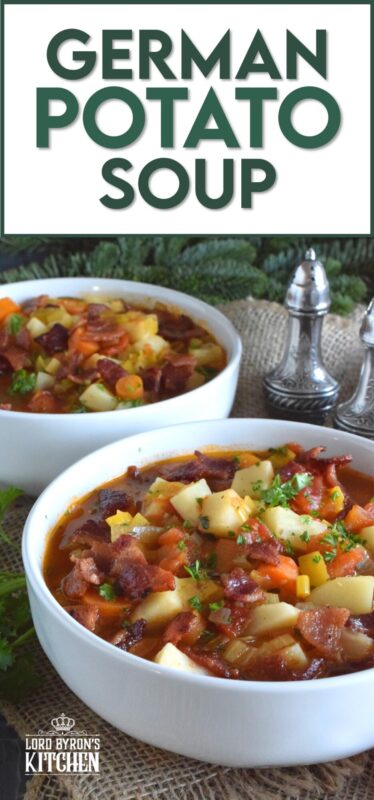German Potato Soup starts off with bacon, which is a great start to any recipe! Loaded with lots of root vegetables like onions, potatoes, celery root, and carrots, this soup also has leeks, which is a wonderful addition to any soup! Hearty and filling, this soup recipe is certainly a keeper!


It’s my favourite time of the year – almost! Christmas is my favourite time of the year, but soup season is a very close second! I love when the weather turns cold and the days get shorter. I get overly excited about piping hot soups, like this German Potato Soup, and I love to wear socks and slippers around the house all day long.
That January and February weather; the cold and the frost, paired with the snow and ice – oh, I love it! Not only do I get to wear fleecy socks and sweaters, but I also get to layer the bed with extra blankets! And, I get to sip hot coffee while watching TV in the late evening, and I get to prepare and eat more soups. There’s a whole list of things I love about colder weather, especially being able to crochet with yarns instead of threads. (Crocheters will know what I’m talking about!)
So, in addition to the socks, sweaters, shorter days, etc., the comfort of home-cooked soups and stews greatly appeals to me. (This post is starting to sound like that song in The Sound of Music… what’s it called? My Favourite Things?) A great dinnertime option, I would wager any time of the year, but more so during the cooler months, is my German Potato Soup. This soup is dense and has such a rich flavour, and the broth is thick and seasoned just perfectly. Let’s dig in!
Make your own online recipe box!
Click the in the lower right corner of your screen
& follow the quick and easy instructions!
INGREDIENTS NEEDED TO PREPARE THIS RECIPE
The following is a list of the ingredients needed to prepare this recipe. For exact amounts and measurements, refer to the printable recipe card located near the bottom of this post.
- Bacon – I’m using thick-cut bacon because I like the texture of it better when it’s fried. Regular-cut bacon is fine too.
- Onion – I use yellow, white, and sweet onions interchangeably. Either of them will do just fine.
- Garlic – Use fresh garlic whenever possible. Even the pre-minced stuff in the jars is better than garlic powder or granulated garlic in this recipe.
- Potatoes – You can use white or yellow flesh potatoes. Peel and dice them into 1/2-3/4 inch chunks.
- Leeks – They are alliums which means they’re related to garlic, chives, shallots, and onions and they have a sweet, oniony flavour.
- Carrots – I’m using small carrots and slicing them into rounds. If you only have larger carrots, you can peel and slice the carrot in half or into quarters lengthwise. Then, slice the carrots into 1/4-inch thick pieces.
- Celery Root – Celery root, also known as celeriac, is a root vegetable. Contrary to popular belief, it is not the root end of the celery you might be most familiar with. More about celery root later!
- Canned Diced Tomatoes – You can buy these in any store, but I like to make my own.
- Vegetable Stock – If you are using store-bought, use low sodium. Some of them can be overly salty!
- Seasonings – Salt, ground black pepper, dried thyme, dried marjoram, dried rosemary, and bay leaves.
- Parsley – For freshness, colour, and garnish.

WHAT IS CELERY ROOT?
As previously mentioned, celery root is also referred to as celeriac. It is a large, bumpy, brown vegetable that’s harvested in the wintertime. It is popular in German and northern European cuisines and is grown around the world. Unlike other types of celery, it is harvested for the round stem (often confused as a root) instead of the green shoots.
The vegetable is peeled to reveal a smooth, white interior, and can be eaten raw or cooked. The skinny stalks and greenery are also edible and are sometimes used for garnish. Because celeriac is less common than celery, it is often sold for three times the price per pound. It is worth noting that in most cases, you will find celery roots sold without the skinny stalks attached.
Before using, celeriac should be scrubbed well. Trim the top and bottom, then use a peeler to remove the brown peel. Use a sharp paring knife to remove bits of roots and hard-to-reach areas as needed. Celeriac will discolour if the peeled flesh is left exposed to air. Either use it right away or submerge it in cold water to use later.
Celeriac has a flavour similar to regular celery, but it’s slightly nutty with a hint of parsley. Unlike celery, it has a firm, nonfibrous texture similar to a turnip. Its flavour is a little more pronounced, especially when comparing cooked celeriac and cooked celery. Cooked celeriac tends to gain sweetness, especially when roasted.
LET’S TALK LEEKS
I love cooking with leeks. I think there are two reasons why I love cooking with leeks so much. Now, before you judge me or think I’m crazy, give me a minute to explain why. First, leeks are inexpensive and super flavourful! They have a mild, onion-like taste. In their raw state, leeks are crunchy and firm, but when they are cooked, they break down and release all of that oniony flavour.
The second reason I like to cook with leeks is where your judging me might come into play. Okay, here goes: they are just so satisfying to chop. Does that make me weird? Do you know what I’m talking about though? When you trim off the top, dark green, tough portion and slice the leek lengthwise to wash out the dirt which might have become trapped in the many layers, those circular layers, and those different shades of greens, really appeal to me.
I find the washing part of a leek very therapeutic. (I’m going to get hate mail, I just know it!) Next, the slicing action is like a dance – really it is! I’ve been practicing my knife skills for years. Every chance I get, I like to practice and hone my fast chopping method. I call it my method because I’m pretty sure it’s not a chef-approved method, but it works for me! So, what I’m trying to say is, when you chop across the leek and all of those shades of green bounce on your cutting board, it’s therapeutic. I promise!

HOW TO CLEAN LEAKS
Begin by chopping off the stringy roots at the bottom and the dark green portion at the top. The dark green part of the stalk can be rather tough and chewy to eat. Remove those and add them to your compost pile or save them if you ever make homemade stock. If you do plan to use them, simply store them in an airtight bag in the freezer until you’re ready to make some.
Next, cut the leek in half lengthwise. Lay each half cut-side-down on your cutting board, and cut them into thin half-moons. Leeks are dirty inside and that’s completely normal. Leeks are often filled with dirt and sand, so cleaning them is an important part of the cutting process.
Once you’ve cut all the leeks into thin slices, add them to a colander. Rinse them under cool running water, tossing them to remove any dirt or debris. When the chopped leeks are clean, use a paper towel or kitchen towel to blot them dry before you start to cook.

HOW TO MAKE GERMAN POTATO SOUP
As with most of my soup recipes, I do recommend that you use a Dutch oven or a heavy-bottomed soup pot with a heavy lid for this German Potato Soup. To start, cut the strips of bacon into half-inch pieces. Add them to the pot and over medium heat, cook until well browned. Use a metal slotted spoon to remove the cooked bacon from the pot and set aside. Next, remove all but two tablespoons of the bacon grease and place the pot back on the burner.
Add the onion to the pot and cook them for 5 minutes, stirring often. Add the garlic and cook for another 2 minutes. Next, carefully add in all of the remaining ingredients with the exception of the fresh parsley. Stir well and bring the soup to a boil. Once boiling, cover and reduce heat to low. Simmer for 40 minutes or until the vegetables are fork-tender.
Taste and adjust seasonings if needed. Add the cooked bacon back into the pot with the soup. You can leave some aside for garnish, or just dump it all in the pot at once. Turn off the heat and add the fresh chopped parsley. Stir well and serve immediately. Garnish with more bacon pieces and fresh parsley if desired.
LEFTOVERS AND/OR FREEZING
This recipe does make about six hearty servings, which might be too much or too little, depending on the size of your family. The recipe can easily be halved or even doubled. Just be sure to use a really big soup pot if you’re doubling this recipe! Once everyone has had their fill, you might have some leftovers. If so, you can transfer the cooled soup to a food-safe container and store it in the fridge. It will keep for at least 3-4 days. Otherwise, you can freeze it and it will last for 3 months.
If you do refrigerate or freeze the leftovers, you may need to add a bit of water to the soup when reheating. Start with just a few tablespoons of water at a time to avoid turning the soup into a broth! Of course, if you add more water, you will need to re-season as well.

SERVING SUGGESTIONS
Even though German Potato Soup is a complete meal all on its own, you might want to consider serving this soup with a few other items. If you have a larger family, you can serve smaller bowls of soup – make it stretch further by serving it with some crusty bread. No matter how thick and hearty the soup is, you cannot go wrong with a slice or two of really good crusty bread. My favourite is just about any bread from Ace Bakery!
Soups are often served with sandwiches and this one is no different. Since you have bacon, potato, and tomato-based soup here, it just makes sense to serve it with a grilled cheese or BLT sandwich. That is if you like grilled cheese sandwiches! I’m not a fan of them, so I would make a grilled cheese for John.e and McKenna, but I would make a BLT (bacon, lettuce, and tomato) sandwich for myself.

Do You Like This Recipe?
You should consider trying these other delicious recipes too!





German Potato Soup
Ingredients
- 8-10 strips thick-cut bacon, cut into 1/2 inch pieces
- 1 large onion, finely chopped
- 2 cloves garlic, minced
- 2 pounds potatoes, peeled and cut into 1/2 inch cubes
- 3 large leeks, trimmed, cut into 1/4 inches slices, washed and drained well
- 4 small carrots, peeled and cut into 1/4 inch rounds
- 1 large celery root, peeled and cut into 1/2 inch cubes
- 4 cups canned diced tomatoes with juice
- 6 cups low sodium vegetable stock
- 1/2 teaspoon dried thyme
- 1/2 teaspoon dried rosemary
- 1/2 teaspoon dried marjoram
- 3/4 teaspoon salt
- 1/2 teaspoon ground black pepper
- 2 whole bay leaves
- 1/4 cup fresh parsley, finely chopped
Instructions
- To start, cut the strips of bacon into half-inch pieces. Add them to the pot and over medium heat, cook until well browned.
- Use a metal slotted spoon to remove the cooked bacon from the pot and set aside.
- Next, remove all but two tablespoons of the bacon grease and place the pot back on the burner.
- Add the onion to the pot and cook them for 5 minutes, stirring often.
- Add the garlic and cook for another 2 minutes.
- Next, carefully add in all of the remaining ingredients with the exception of the fresh parsley. Stir well and bring the soup to a boil.
- Once boiling, cover and reduce heat to low. Simmer for 40 minutes or until the vegetables are fork-tender.
- Taste and adjust seasonings if needed.
- Add the cooked bacon back into the pot with the soup. You can leave some aside for garnish, or just dump it all in the pot at once.
- Turn off the heat and add the fresh chopped parsley. Stir well and serve immediately.
- Garnish with more bacon pieces and fresh parsley if desired.
Nutrition
Did you make this recipe?
Upload a photo and tag me so that I can see it!
















Sharon says
My husband and I love homemade soups and we found this one so flavorful. I have never used celery root before and despite it being a bit pricey, it added a new dimension of flavor we enjoyed. We’ll definitely make this again. It made me wonder if I can grow celery root. We used our own tomatoes for this recipe.
Raymond says
This is so delicious! I made this and my wife and I both thoroughly enjoyed it. The second day it was even better . I do plan to make this again and again . Thank you for sharing this delicious recipe.
Barbara J Rediker says
I love leeks too! And I agree with you on the cleaning of them. I do it the same way and find it so fun! I’m saving your soup to try because I’ve never used celery root either and this sounds delicious.